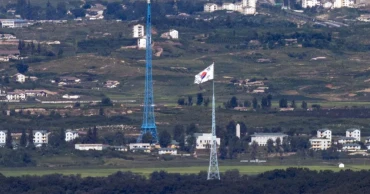U.S
Wall Street falls ahead of mammoth week with Fed, earnings
Stocks are falling on Wall Street Monday ahead of a week full of potentially market-moving events, from decisions on interest rates around the world to earnings reports from the biggest U.S. companies.
The S&P 500 was 0.7% lower in midday trading, giving back some of its gains from last week when it reached its highest level since early December. The Dow Jones Industrial Average was down 60 points, or 0.2%, at 33,917, as of 12:15 p.m. Eastern time, and the Nasdaq composite was 1.2% lower.
Markets have been veering recently on worries that the economy and corporate profits may be set for a steep drop-off, along with competing hopes that cooling inflation will get the Federal Reserve to take it easier on interest rates.
The central bank’s next decision on rates is coming Wednesday, and most investors expect it to announce an increase of just 0.25 percentage points. That would be the smallest increase since March, following a spate of hikes of 0.75 points and then a 0.50-point increase, and it would mean less added pressure on the economy.
Higher rates combat inflation by intentionally slowing the economy, while also dragging down on prices for investments. Inflation has been cooling since the summer amid last year's blizzard of rate hikes, but the economy has also been showing signs of concern.
The big question is whether Fed Chair Jerome Powell on Wednesday afternoon will give markets what they want to hear — hints that rate hikes will end soon and rate cuts may even be possible late this year — or stick to the Fed’s mantra that it plans to keep rates higher for longer, even if a modest recession hits.
“I think that they have no intention of cutting rates this year,” said Sam Stovall, chief investment strategist at CFRA Research, adding that the Fed waits an average of roughly nine months after its last rate hike before cutting.
“They’ll reiterate that they don’t want to make the mistakes of the 1970s," he said, "but I think in the back of their minds, they’re going to say no matter which inflationary indicator you look at, they’re all heading in a stairstep downward pattern.”
Read more: Wall Street braces for earnings to get hit by inflation
Central banks for Europe and for the United Kingdom are also set to announce their latest increases for rates this week.
Beyond interest rates, more than 100 companies in the S&P 500 are scheduled this week to report how much profit they made in the last three months of 2022. Among them are tech heavyweights Apple, Amazon, and Google’s parent company. Because these companies are three of the four biggest on Wall Street by market value, their stock movements carry much more sway on the S&P 500 than others.
Apple's 1.4% drop Monday, for example, was one of the heaviest weights on the S&P 500.
The only other stock that rivals them in size, Microsoft, shook Wall Street last week when it gave forecasts for upcoming results that raised worries about a slowdown in corporate spending on tech. Its stock fell 1.8% Monday.
Companies generally look to be on track to report slightly weaker profit for the end of 2022 than expected, according to a BofA Global Research report. That’s an indication that the strong January enjoyed by the S&P 500 so far is more about improving sentiment on Wall Street than about better fundamentals, strategist Savita Subramanian wrote.
Strategists at Morgan Stanley led by Michael Wilson warn tougher times may be ahead.
“The reality is that earnings are proving to be even worse than feared based on the data, especially as it relates to margins,” they wrote in a report. “Secondly, investors seem to have forgotten the cardinal rule of ‘Don’t Fight the Fed’. Perhaps this week will serve as a reminder.”
Later this week, the U.S. government will also give its latest monthly update on the job market. Hiring has remained remarkably resilient across the broad economy, even as housing and other corners weaken sharply under the weight of all the Fed’s rate hikes from last year.
Some big tech companies have announced high-profile layoffs after acknowledging they misread their boom coming out of the pandemic. But job cuts may be starting to spread to other areas of the economy. Hasbro and 3M last week announced layoffs.
All told, economists expect Friday’s report to show that U.S. employers added 187,500 more jobs than they cut during January. That would be a slowdown from December’s hiring of 223,000.
The yield on the 10-year Treasury rose to 3.54% from 3.51% late Friday. The two-year yield, which tends to move more on expectations of Fed actions, rose to 4.29% from 4.20%.
2 years ago
US nears new cooperation deals with Pacific Island nations
The Biden administration is nearing deals with two Pacific Island nations to extend ties that are considered critical to maintaining balance in the U.S.-China rivalry for influence in a region where the Chinese are rapidly expanding their economic, diplomatic and military clout.
This week, the U.S. signed memorandums of understanding with the Marshall Islands and Palau that administration officials hope will pave the way for the quick completion of broader agreements that will govern the islands' relations with Washington for the next two decades. Those ties grant the U.S. unique military and other security rights on the islands in return for substantial aid.
The administration believes that extending those so-called “Compacts of Free Association” agreements will be key to efforts to retain American power and blunt Chinese assertiveness throughout the Indo-Pacific.
The memorandums signed this week lay out the amounts of money that the federal government will provide to the Marshall Islands and Palau if their compacts are successfully renegotiated. Negotiations on a similar memorandum with a third compact country, Micronesia, are ongoing.
The current 20-year compacts with the Marshall Islands and Micronesia expire this year; the current compact with Palau expires in 2024 but administration officials said they believe all three can be renewed and signed by mid- to late-spring.
Officials would not discuss specifics of the amounts of money involved because the deals aren’t yet legally binding and must still be reviewed and approved by Congress as part of the budget process.
A Micronesian news outlet, Marianas Variety, reported Thursday that the Marshall Islands will receive $700 million over four years under the memorandum that it signed. But that amount would cover only one-fifth of a 20-year compact extension and does not include the amount Palau would receive.
Joe Yun, Biden's special presidential envoy for compact negotiations, said the amounts will be far greater than what the U.S. had provided in the past.
Read more: Australia to reopen island detention camp after refugee bill
Islanders have long complained that the previous compacts they signed did not adequately address their needs or long-term environmental and health issues caused by U.S. nuclear testing in the 1950s and '60s. Lawmakers had expressed concern dating back to 2021 that the administration was not giving enough attention to the matter.
Yun, who signed the memorandums with representatives of the Marshalls and Palau on Tuesday and Wednesday in Los Angeles, said the Marshall Islands, in particular, would be compensated for such damage and would be given control over how that money is spent.
Yun said it would pay “nuclear-affected communities' health, welfare and development” and also noted that the U.S. had committed to building a new hospital as well as a museum in the Marshalls to preserve the memory and legacy of their role, notably in the Pacific theater during WWII.
This week's signings clear the way for individual federal agencies — including the Postal Service, the Federal Aviation Administration, the Federal Emergency Management Agency, and the National Weather Service — to negotiate their own agreements with the Marshalls and Palau, which will then become part of the broader compacts.
Along with the federal money, those agencies provide their services to the islands. In return, the U.S. is given unique military and national security basing rights and privileges in an area where China is increasingly flexing its muscles.
Yun said China did not come up specifically in the negotiations but it was a major element in all sides' discussions.
“The threat from China is unstated but there is no question that China is a factor,” Yun said. Not only does China have a large and growing economic presence in the region, but the Marshall Islands and Palau both recognize Taiwan diplomatically. “They are coming under Chinese pressure,” he said.
China has steadily poached allies from Taiwan in the Pacific, including Kiribati and the Solomon Islands in 2019. The U.S. announced plans last year to reopen an embassy in the Solomon Islands, which has signed a security agreement with China.
Since World War II, the U.S. has treated the Marshall Islands, along with Micronesia and Palau, much like territories. On the Marshall Islands, the U.S. has developed military, intelligence and aerospace facilities in a region where China is particularly active.
In turn, U.S. money and jobs have benefited the islands’ economy. And many islanders have taken advantage of their ability to live and work in the U.S., moving in the thousands to Arkansas, Guam, Hawaii, Oregon and Oklahoma.
Many on the Marshall Islands believe a U.S. settlement of $150 million agreed to in the 1980s fell well short of addressing the nuclear legacy. But the U.S. position has remained static for more than 20 years, the last time the compact came up for renegotiation.
Various estimates put the true cost of the damage at about $3 billion, including for repairs to a massive nuclear waste facility known as the Cactus Dome which environmentalists say is leaking toxic waste into the ocean.
Read more: Bangladesh to get US support in improving, widening coastal embankments
The U.S. Department of Energy says the dome contains over 100,000 cubic yards (76,000 cubic meters) of radioactively contaminated soil and debris but the structure isn’t in any immediate danger of failing.
2 years ago
Wall Street braces for earnings to get hit by inflation
Wall Street expects companies to face a reckoning with the realities of hot inflation, a slowing economy and rising interest rates in the latest round of earnings results.
Analysts are forecasting an earnings contraction of about 3.5% for the fourth quarter, according to FactSet. That estimate, as of the end of last year, is an about-face from forecasts back in September of 3.5% growth and a sharp reversal from 8.5% growth forecasts in June.
The dismal forecast for the fourth quarter follows is part of a trend of shrinking earnings growth throughout 2022 as inflation tightened its grip on consumers. Spending remained strong in many retail areas and companies raised prices on everything from food to clothing to offset the impact of higher raw material costs and inflation in general. Many companies went further than just maintaining profits and increased their profit margins.
Corporate profits, though, aren’t likely going to continue bucking an economy that showed clear signs of damage during the fourth quarter, particularly with consumers increasingly cutting back on spending. Many analysts have been forecasting that the economy will slip into some level of recession in 2023 and company profits are starting to reflect that. The Federal Reserve’s aggressive fight against inflation carries the risk of slowing the economy too much.
Read more: Wall Street points lower after two days of gains
Morgan Stanley, in a December report, warned investors to brace for a rough round of corporate earnings in the coming month and into the rest of 2023.
“The fixation on inflation and the Fed continues, but markets appear to have moved past it and onto the real concern— earnings growth/recession,” the report said. “Rates and inflation may have peaked but we see that as a warning sign for profitability, a reality we believe is still underappreciated but can no longer be ignored.”
Analysts expect communications companies and technology firms to be among the biggest losers during the fourth quarter. Lower demand has been cutting into technology product sales and that has in turn led to warnings from chipmakers and other companies. Computer maker HP and chipmaker Micron have both announced job cuts as a part of their plans to deal with weaker demand. Analysts are forecasting a slight earnings contraction for both companies.
The weakening economy has cut into advertising budgets, which have raised concerns for companies including Facebook and Google. Retailers and other companies that rely on discretionary spending are also expected to get hit hard in the fourth quarter.
Read more: Asian shares decline after retreats on Wall Street, Europe
Analyst expect energy companies to keep powering past other sectors as the big earnings winners during the fourth quarter. The sector has outperformed all others in 2022 amid higher oil and natural gas prices.
2 years ago
Beijing threatens response to ‘unacceptable’ virus measures
The Chinese government sharply criticized COVID-19 testing requirements imposed on passengers from China and threatened countermeasures against countries involved, which include the U.S. and several European nations.
“We believe that the entry restrictions adopted by some countries targeting China lack scientific basis, and some excessive practices are even more unacceptable,” Foreign Ministry spokesperson Mao Ning said at a daily briefing Tuesday.
“We are firmly opposed to attempts to manipulate the COVID measures for political purposes and will take countermeasures based on the principle of reciprocity,” she said. Mao did not specify what steps China might take.
The comments were China’s sharpest to date on the issue. Australia and Canada this week joined a growing list of countries requiring travelers from China to take a COVID-19 test prior to boarding their flight, as China battles a nationwide outbreak of the coronavirus after abruptly easing restrictions that were in place for much of the pandemic.
Other countries including the U.S., U.K., India, Japan and several European nations have announced tougher COVID-19 measures on travelers from China amid concerns over a lack of data on infections in China and fears of the possibility that new variants may emerge.
French Prime Minister Elisabeth Borne defended the tests. Starting Wednesday, anyone flying from China to France will have to present a negative virus test taken within the previous 48 hours and be subject to random testing on arrival.
“We are in our role, my government is in its role, protecting the French,” Borne said Tuesday on France-Info radio.
The U.K. will require that passengers from China take a COVID test before boarding the plane from Thursday. Transport Secretary Mark Harper said the requirement is for “collecting information” because Beijing isn’t sharing coronavirus data.
Health officials will test a sample of passengers when they arrive in the U.K., but no quarantine is required for those who test positive, he said.
“The policy for arrivals from China is primarily about collecting information that the Chinese government is not sharing with the international community,” Harper told the LBC radio station on Tuesday.
Sweden’s Public Health Agency said Tuesday that it had urged the government to require travelers from China to present a recent negative COVID-19 test.
The statement from the agency comes as Sweden, which has taken over EU’s rotating presidency, has called a meeting of the EU’s crisis management mechanism for Wednesday to try to agree on a common European line.
Read more: Lack of info on China’s COVID-19 surge stirs global concern
The Swedish government “is preparing to be able to introduce travel restrictions. At the same time, we are conducting a dialogue with our European colleagues to get the same rules as possible in the EU,” Justice Minister Gunnar Strömmer said in a statement.
Austria, too, plans to test the wastewater of all planes arriving from China for new variants of the coronavirus, the Austria Press Agency reported Tuesday, following a similar announcement by Belgium a day earlier.
Chinese health officials said last week that they had submitted data to GISAID, a global platform for sharing coronavirus data.
The versions of the virus fueling infections in China “closely resemble” those that have been seen in different parts of the world between July and December, GISAID said Monday.
Dr. Gagandeep Kang, who studies viruses in the Christian Medical College of Vellore in India, said that the information from China, albeit limited, seemed to suggest that “the pattern was holding” and that there wasn’t any sign of a worrisome variant emerging.
Mao, the Chinese Foreign Ministry spokesperson, said that health authorities had recently held a video conference with the WHO to exchange views on the current COVID situation, medical treatment, vaccination and other technical issues, and agreed to continue technical exchanges to help end the pandemic as soon as possible.
A senior Hong Kong official also criticized the steps taken by some other countries. Some countries have applied the requirements to passengers from Hong Kong and Macao, both semiautonomous Chinese territories, as well as mainland China.
Hong Kong Chief Secretary Eric Chan said in a Facebook post that the government had written to various consulates on Monday to express its concerns over the “unnecessary and inappropriate” rules.
Some Canadian experts have questioned the effectiveness of the testing. Kerry Bowman, assistant professor at the University of Toronto’s Temerty Faculty of Medicine, said that people can test positive long after entering the country.
The requirement is “not based on science at this point,” he said after Canada announced measures last weekend.
Read more: China to resume issuing passports, visas as virus curbs ease
China, which for most of the pandemic adopted a “zero-COVID” strategy that imposed harsh restrictions aimed at stamping out the virus, abruptly eased those measures in December.
Chinese authorities previously said that from Jan. 8, overseas travelers would no longer need to quarantine upon arriving in China, paving the way for Chinese residents to travel.
2 years ago
Southwest under scrutiny after wave of storm cancellations
Major U.S. airlines were broadsided by the massive weekend winter storm that swept across large swaths of the country but had largely recovered by Tuesday, except for one.
Problems at Southwest Airlines appeared to snowball after the worst of the storm passed. It cancelled more than 70% of its flights Monday, more than 60% on Tuesday, and warned that it would operate just over a third of its usual schedule in the days ahead to allow crews to get back to where they needed to be.
American, United, Delta and JetBlue, suffered cancellations rates of between none and 2% by Tuesday.
The disparity has triggered a closer look at Southwest operations by the U.S. Department of Transportation, which called the rate of cancellations “disproportionate and unacceptable,” and sought to ensure that the Dallas carrier was sticking by its obligations to stranded customers.
The size and severity of the storm created havoc for airlines. Airports were overwhelmed by intense snowfall and drifts. Airlines cancelled as many as 20% of their flights Saturday and Sunday and Buffalo Niagara International Airport, close to the epicenter of the storm, remains closed Tuesday.
Read more: Northwestern US heat wave could have hottest day on Tuesday
Yet it has become clear that Southwest is suffering a disproportionate disruption. Of the approximately 2,950 flight cancellations in the U.S. by midday Tuesday, 2,549 were called off by Southwest.
Southwest spokesman Jay McVay said at a press conference in Houston that cancellations snowballed as storm systems moved across the country, leaving flight crews and planes out of place.
“So we’ve been chasing our tails, trying to catch up and get back to normal safely, which is our number one priority as quickly as we could,” he said. “And that’s exactly how we ended up where we are today.”
Passengers stood in long lines trying to rebook their flights.
The Department of Transportation said on Twitter that it was “concerned by Southwest’s unacceptable rate of cancellations and delays & reports of lack of prompt customer service.” The tweet said the department would look into whether Southwest could have done anything about the cancellations and whether the airline was complying with its customer service plan.
Bryce Burger and his family were supposed to be on a cruise to Mexico departing from San Diego on Dec. 24, but their flight from Denver was cancelled without warning or notice, he said Tuesday. The flight was rebooked through Burbank, California, but that flight was canceled while they sat at the gate.
“Just like my kids’ Christmas sucks. It’s horrible,” Burger said by phone from Salt Lake, where the family decided to drive after giving up the cruise.
The family’s luggage is still at the Denver airport and Burger doesn’t know if he can get a refund for the cruise because the flight to California was booked separately.
Burger’s call logs show dozens of unsuccessful attempts to reach Southwest over two days. The company did responded to a tweet he sent. He said they offered him and his family each a $250 voucher.
Read more: Mild cold wave likely in Bangladesh this week
Southwest did not comment immediately on Tuesday and information related to the cancellations was last updated on the company’s site Monday.
The president of the union representing Southwest pilots blamed the lack of crews to fly planes on scheduling software written in the 1990s and on management that he said failed to fix things after previous meltdowns, including a major disruption in October 2021.
“There is a lot of frustration because this is so preventable,” said the union official, Capt. Casey Murray. “The airline cannot connect crews to airplanes. I’m concerned about this weekend. I’m concerned about a month from now.”
3 years ago
N. Korea fires ballistic missiles after US-S. Korea drills
North Korea fired two short-range ballistic missiles toward its eastern waters on Friday, its latest weapons demonstration that came days after U.S. and South Korean warplanes conducted joint drills that North Korea views as an invasion rehearsal.
North Korea has conducted an unprecedented number of missile tests this year in what some experts call an attempt to bolster its weapons capability and pressure its rivals to make concessions such as sanctions relief in future negotiations. Recently, the North also claimed to have performed major tests needed to acquire its first spy satellite and a more mobile intercontinental ballistic missile capable of reaching the U.S. mainland.
South Korea’s military detected the two missile launches from North Korea’s capital region at around 4:32 p.m. on Friday. Japan said it also confirmed at least one missile launch by North Korea.
It wasn’t immediately clear exactly what kinds of missiles North Korea fired. South Korea’s military said the missiles traveled about 250 kilometers (155 miles) and 350 kilometers (220 miles) respectively before landing in the waters between the Korean Peninsula and Japan.
Japanese Vice Defense Minister Toshiro Ino said that one missile detected by Japan flew as far as 300 kilometers (180 miles) at a maximum altitude of 50 kilometers (30 miles). He said that missile might have showed an “irregular” trajectory, a possible reference to North Korea’s highly maneuverable, nuclear-capable KN-23 missile, which was modeled on Russia’s Iskander missile.
South Korea’s military called the launches “a grave provocation” that hurts international peace. It said South Korea will maintain a firm readiness and closely monitor North Korean moves in coordination with the United States. Ino also accused North Korea of significantly raising tensions with repeated weapons tests.
Read more: N Korea fires 2 ballistic missiles in resumption of testing
The launches could be a response to the U.S.-South Korean aerial military exercises near the Korean Peninsula on Tuesday, as North Korea has said its torrid run of testing activities in past months were meant as a warning over its rivals’ previous combined drills. Washington and Seoul have said their drills are defensive in nature, but North Korea calls them practice for an invasion.
The latest U.S.-South Korean drills drew B-52 nuclear-capable bombers and F-22 stealth fighter jets from the United States and other advanced warplanes from South Korea. The training was part of a bilateral agreement on boosting a U.S. commitment to defend its Asian ally with all available military capabilities, including nuclear, according to South Korea’s Defense Ministry.
The F-22 jets were supposed to stay in South Korea for more joint drills this week with the South Korean air force, but the U.S. aircraft eventually returned to their base in Japan due to weather conditions, South Korean defense officials said.
The aerial drills came after North Korea said it used old missiles as launch vehicles to test cameras and other systems on Sunday for the development of its first military reconnaissance satellite. Its state media also published low-resolution photos of South Korean cities as viewed from space.
Some civilian experts in South Korea said the photos were too crude for surveillance purposes and that the launches were likely a cover for tests of North Korea’s missile technology. South Korea’s military has maintained North Korea fired two medium-range ballistic missiles.
Such assessments have infuriated North Korea, with the powerful sister of North Korean leader Kim Jong Un issuing crude insults of unidentified South Korean experts. Kim Yo Jong said there was no reason to use an expensive, high-resolution camera for a single-shot test.
Kim Yo Jong also scoffed at South Korea’s previous assessment that North Korea still has technological hurdles to overcome to acquire functioning ICBMs that can launch nuclear strikes on the U.S. homeland — such as the ability to protect its warheads from the harsh conditions of atmospheric reentry.
To prove the North’s ICBM capability, she suggested that North Korea might carry out a standard-trajectory ICBM launch. All of the North’s previous ICBM launches were made at a steep angle to avoid neighboring countries. A normal-angle ICBM launch could sharply inflame regional animosities and trigger a strong response from the U.S. as the weapon would fly toward the Pacific Ocean.
Read more: North Korea fires new type of short-range ballistic missiles
A spy satellite and a solid-fueled ICBM are among the high-tech weapons systems that Kim Jong Un has vowed to introduce to cope with what he calls U.S. hostility. Other weapons systems he wants to procure include missiles with multi-warheads, underwater-launched nuclear missiles, nuclear-powered submarines and hypersonic missiles.
Last week, North Korea tested a “high-thrust solid-fuel motor” that experts say would be used for a solid-fueled missile, which is more agile and harder to detect before launches than liquid-fueled weapons.
3 years ago
What's the 4-nation Quad, where did it come from?
Leaders of the U.S., Japan, Australia and India gathered in Tokyo on Tuesday for a summit of the “Quad.” What is the group, where did it come from and why do diplomats keep coming up with strange names for various partnerships?
WHAT IS THE QUAD?
Formally the Quadrilateral Security Dialogue, the Quad began as a loose partnership after the devastating 2004 Indian Ocean tsunami, when the four countries joined together to provide humanitarian and disaster assistance to the affected region. It was formalized by former Japanese Prime Minister Shinzo Abe in 2007, but then fell dormant for nearly a decade, particularly amid Australian concerns that its participation in the group would irritate China.
The group was resurrected in 2017, reflecting changing attitudes in the region toward China’s growing influence. Both the Trump and Biden administrations saw the Quad as key to a pivot toward placing more focus on the Indo-Pacific region, particularly as a counterweight to China’s assertive actions. The Quad leaders held their first formal summit in 2021 and met again virtually in March.
Also read: India, US Likely To Move Forward On Set Of initiatives In 2022: White House
IS IT AN “ASIAN NATO”?
China has complained that the group represents an attempt at forming an “Asian NATO,” though unlike the European alliance there is no mutual-defense pact in effect. Quad members say the group is meant to deepen economic, diplomatic and military ties among the four countries. And while they don’t often explicitly say it, those partnerships are meant to be a bulwark against Chinese aggression. In a March 2021 declaration laying out the “Spirit of the Quad,” the leaders said, “We bring diverse perspectives and are united in a shared vision for the free and open Indo-Pacific.We strive for a region that is free, open, inclusive, healthy, anchored by democraticvalues, and unconstrained by coercion.”
WHO ARE THE NEW FACES?
Tuesday’s meeting marks the first in-person gathering of the group for Japanese Prime Minister Fumio Kishida, who took office last October, as well as for Australia's new prime minister, Anthony Albanese. He was sworn-in on Monday, just two days after Australia’s parliamentary election and one day before the summit.
WHAT ABOUT INDIA?
Indian Prime Minister Narendra Modi is attending as he faces increasing global scrutiny over his government’s crackdown on minorities and some authoritarian tendencies. In addition, while the other members of the Quad have been united in standing up against Russia’s invasion of Ukraine, especially with sanctions, India increased its purchases of Russian energy supplies after the invasion. Moreover, the invasion has led to food shortages that are causing price spikes, yet India banned wheat exports following a heat wave that could make this global challenge much tougher to resolve.
WHO ELSE IS INVOLVED?
South Korea has expressed interest in joining the Quad, though U.S. officials have said they are not contemplating adjusting the group’s membership. The group has held “Quad-plus” meetings that have included South Korea, New Zealand and Vietnam, which could form the basis for future expansion or partnership in the region.
Also read: Urge ASEAN, QUAD friends to distance from Myanmar military: Dhaka to Washington
WHY THE ODD NAME?
Diplomats can't help themselves. Once they start up different pairings or partnerships, they can't resist assigning shorthand names like the Quad or baffling acronyms like AUKUS (the new Australia- U.K.-U.S. alliance.) Another acronym that got attention this week while President Joe Biden was in Asia: IPEF, short for the U.S.-proposed new trade pact called the Indo-Pacific Economic Framework.
3 years ago
Average US gas price rises 22% in two weeks to record $4.43
The average U.S. price of regular-grade gasoline shot up a whopping 79 cents over the past two weeks to a record-setting $4.43 per gallon (3.8 liters) as Russia’s invasion of Ukraine is contributing to already-high prices at the pump.
Industry analyst Trilby Lundberg of the Lundberg Survey said Sunday the new price exceeds by 32 cents the prior all-time high of $4.11 set in July 2008. But that’s still quite a ways from the inflation-adjusted record high of about $5.24 per gallon.
Read:Yet another 4-decade inflation high is expected for February
The price at the pump is $1.54 higher than it was a year ago.
Lundberg said gas prices are likely to remain high in the short term as crude oil costs soar amid global supply concerns following Russia’s invasion of Ukraine.
Prices at the pump were rising long before Russia invaded Ukraine as post-lockdown demand has pushed prices higher. Crude prices plummeted in early 2020 as economies around the world shut down because of COVID-19 — the price of futures even turned negative, meaning some sellers were paying buyers to take oil. Prices rebounded, however, as demand recovered faster than producers pulled oil out of the ground and inventories dried up.
Then, the price increase accelerated after war began.
Energy prices are also contributing to the worst inflation that Americans have seen in 40 years, far outpacing higher wages.
Nationwide, the highest average price for regular-grade gas is in the San Francisco Bay Area, at $5.79 per gallon. The lowest average is in Tulsa, Oklahoma, at $3.80 per gallon.
Read:Asia stocks mixed after Wall St falls, US bans Russian oil
According to the survey, the average price of diesel also spiked, up $1.18 over two weeks, to $5.20 a gallon. Diesel costs $2.11 more than it did one year ago.
3 years ago
China says U.S. accusation on South China Sea ‘completely unjustified’
A spokesperson of the Chinese embassy in the United States on Monday said the accusation against China on the South China Sea issue is ‘completely unjustified’.
The statement that the U.S. Department of State issued earlier in the day disregards the efforts of China and ASEAN countries for peace and stability in the South China Sea.
However, it deliberately distorts the facts and international law including the United Nations Convention on the Law of the Sea (UNCLOS), exaggerates the situation in the region and attempts to sow discord between China and other littoral countries, the spokesperson said.
"China's position on the South China Sea issue has been consistent and clear-cut," said the spokesperson.
The spokesperson noted that the situation of the South China Sea has remained peaceful and stable and is still improving.
China and other littoral countries have maintained dialogue and communication through consultation mechanisms on maritime affairs, and worked to promote cooperation over the South China Sea.
Within the framework of fully and effectively implementing the Declaration on the Conduct of Parties in the South China Sea, China and ASEAN countries are advancing the consultation on a Code of Conduct in the South China Sea and are making visible progress, the spokesperson said.
5 years ago
U.S. beat Costa Rica 1-0 in soccer friendly
18-year-old Uly Llanez converted a penalty in his national team debut to help the U.S. claim a 1-0 victory against Costa Rica in a friendly match on Saturday.
5 years ago







.jpg)
.jpg)







